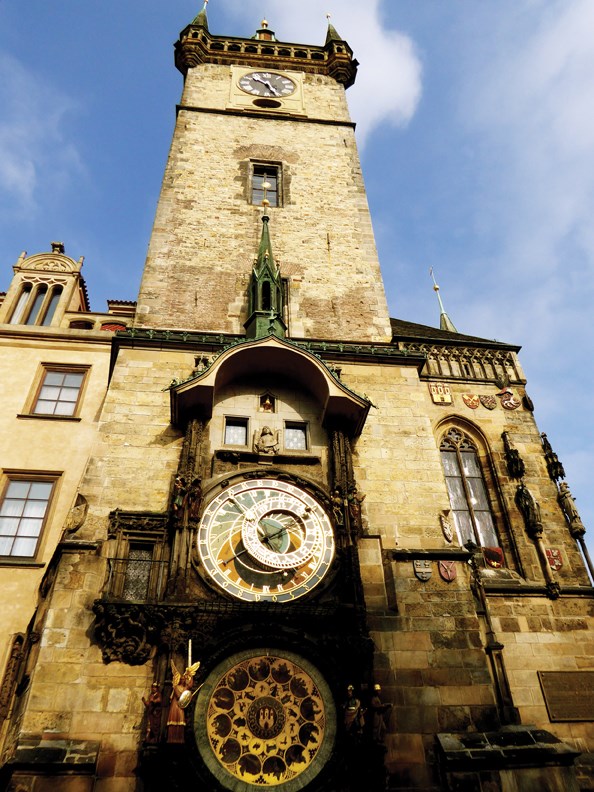A three-day extension in Prague wraps up our Elbe River cruise with Viking. We explore this renowned city with other eager first timers.
Starting out at the old city gate, a guide introduces us to the World Heritage town centre. Magnificent pastel buildings surround the immense cobblestone square. Soft yellow Storch House displays paintings of Wenceslas, Bohemia’s patron saint. Pink Kinsky Palace displays decorative sculptures and battle shields. Several feature Renaissance façades with wonderful sgraffito, etched layers of contrasting coloured plaster.
An enormous bronze monument recalls church reformer John Hus, burned here at the stake a century before the Protestant Reformation. On the opposite corner, lively musicians dressed in leather vests, flowing pants and curly-toed shoes play drums, wooden flutes and horns. Their haunting medieval music fills the air. Hussite Tyn Church, whose towers are said to have inspired Disney’s Sleeping Beauty Castle, rises dramatically behind them.
Behind us, Old Town Hall’s lofty towers boast a working, 15th century astronomical clock. Twelve apostles parade hourly above the gold-embellished clock-face. A guided tour takes us inside town hall through the council chamber and assembly room, each adorned with mosaics and paintings illustrating local history. The chapel displays regal emblems of Wenceslas IV and reveals the intricate mechanism moving the carved apostles. Our tour ends in cellars predating Town Hall’s establishment in 1338. Here, Romanesque and Gothic houses are revealed.
Streets fan out from the central square. On one stands the neoclassical Estate Theatre. Banners fluttering on the balcony declare that Mozart premiered his Don Giovanni opera here. Along others, we discover the 13th century Jewish ghetto where Frank Kafka, Karel Capek and Albert Einstein lived. Cafés, shops, synagogues, a ceremonial hall and cemetery remain.
A shuttle whisks us up to the hilltop castle district, a complex of early churches, immaculate gardens, royal residences and viewpoints providing panoramic city views. Since the 9th century, Bohemian kings, emperors and Czechoslovakian presidents ruled from Prague Castle, the world’s largest ancient castle. Adjacent, St. Vitus Church proves equally spectacular. An exterior mosaic of the last judgment seems to urge sinners to enter and repent. Inside, one chapel contains bedazzling silver angels holding up St. John’s tomb. Other chapels entomb exalted royalty, including King Wenceslas amid paintings that depict his 10th century benevolence.
Joining a special excursion next day, we return to the castle district and visit privately owned Lobkowicz Palace. Following an elegant luncheon in the ballroom, a string trio entertains us in the music chamber. A stroll through the family museum reveals masterpieces by Canaletto, Brueghel, Cranach and Velázquez. Several paintings portray the family’s rise to power during the Thirty Years War. Gallery portraits acclaim their royal lineage and commemorate their beloved dogs. Among a large collection of musical instruments, we see original manuscripts given to family benefactors, like Beethoven’s Eroica dedicated to Prince Lobkowicz.
The iconic 14th century Charles Bridge concludes our stay. The Holy Roman Empire’s first elected Bohemian emperor, Charles IV, graces the portal. Crossing the bridge, we delight in panoramic cityscapes and 30 marble saints lining the balustrade. Below St. John’s sculpture, a bronze plaque shows him receiving the queen’s confession and then being thrown into the Vltava River for keeping her secrets. And with hundreds of other visitors, we browse jewelry displays, paintings and handicrafts while all along the way, buskers belt out lively music.
Once meeting places for philosophers, writers and scientists, old town’s bistros now attract travellers. At a cozy eatery near the bridge, patrons relax on the street-side patio. Some typically enjoy coffees and honey cakes; others opt for traditional dumplings. We spoon hearty goulash from bread bowls and sip local beers from breweries thriving since 993.



